Quasi Vivo流动培养建立糖尿病模型
——细胞间cross-talk研究
营养过剩表现为代谢谱的变化和胰岛素敏感度的损伤。早期以静态培养方式为基础的体外研究只能提供单个细胞中单分子途径的大量信息,尽管已经在局部细胞水平上对稳态、炎症和损伤的信号传导机制进行了充分的研究,但不能用于研究单个细胞或组织的变化信号是如何传达给身体的其他部位,不同组织之间的cross-talk如何决定全身代谢水平。
以QV500流动细胞培养为基础建立的三维脂肪组织+内皮细胞+肝细胞(AT+EC+HEP)流动培养法通过培养基的流动经串联培养室连接起来,以模拟血液连接身体中的不同组织或器官。
此流动培养模型通过为细胞及时补充营养物质、增加供氧量,并且还能为细胞提供由培养基的流动和细胞的crosstalk产生的间质样剪切应力来维持高的细胞活力,在体外系统地重建内源代谢,是研究不同位置的许多关键器官的具体功能和如何通过器官之间的相互作用来维持全身能量平衡的有力工具。(Iori, E., et al. Glucose and Fatty Acid Metabolism in a 3 Tissue In-Vitro Model Challenged with Normo- and Hyperglycaemia. PLoS ONE. 2012; 7: e34704; Vozzi, F., et al. A flexible bioreactor system for constructing in vitro tissue and organ models. Biotechnol Bioeng. 2011; 108: 2129–2140)

图 1 三维脂肪组织+内皮细胞+肝细胞(AT+EC+HEP)流动培养法的示意图。Quasi Vivo 生物反应器 (QV500) 培养肝细胞和脂肪组织用低剪切的培养室,而用于内皮细胞的层流室(LFC)采用的是高剪切。
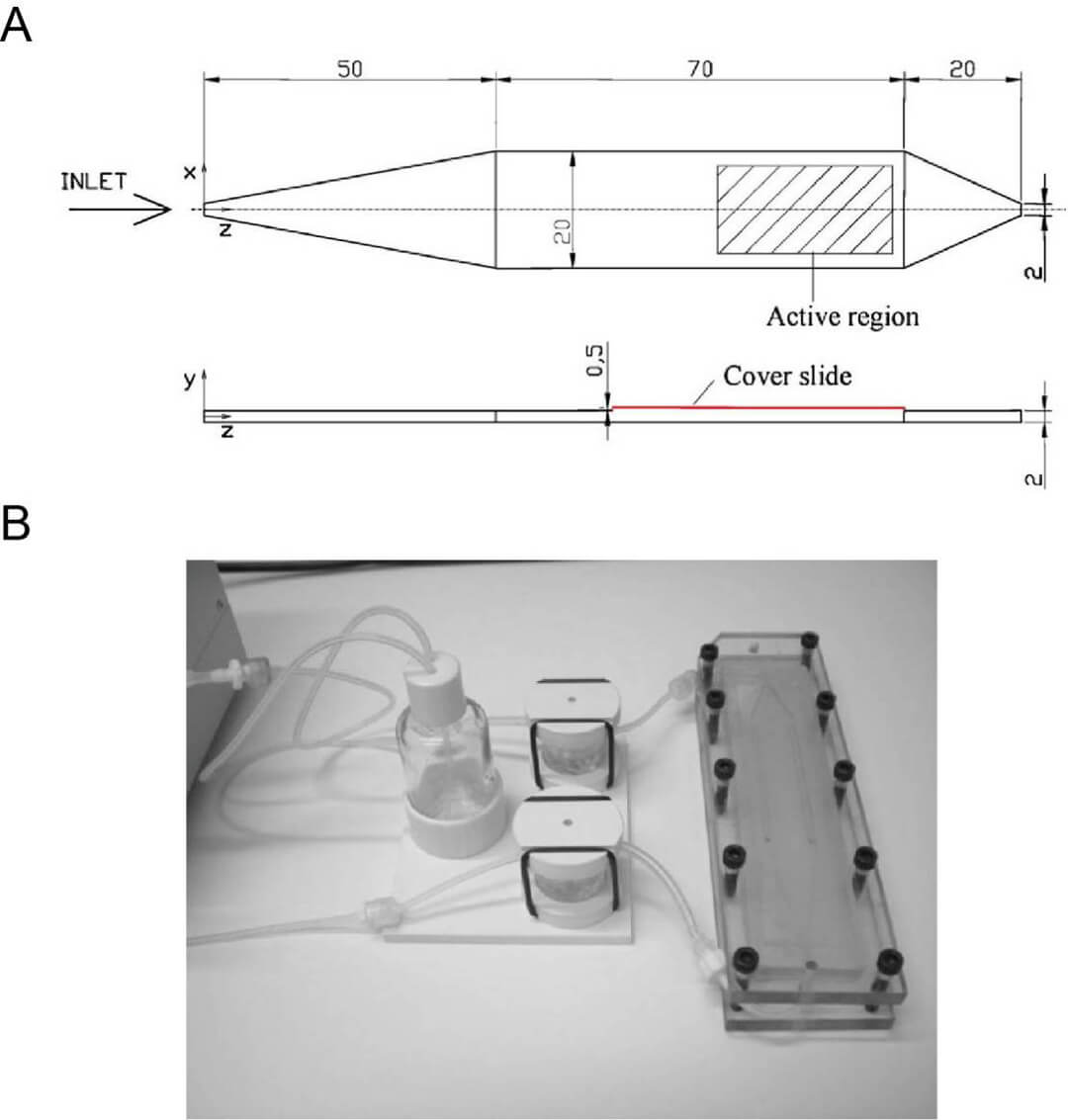
图2. 内皮细胞培养用的高剪切层流室(LFC)(A) LFC设计图。(B)组装入流动培养反应器中的LFC, 本图中采用的是Quasi Vivo流动培养系统的原型机(Vozzi, 2011)。
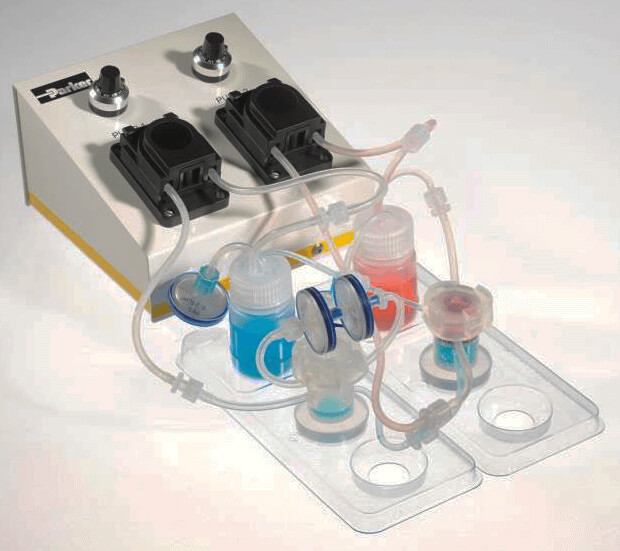
图3. 目前商品化的QV500流动培养系统操作更简单,使用更方便。适合低通量的实验。
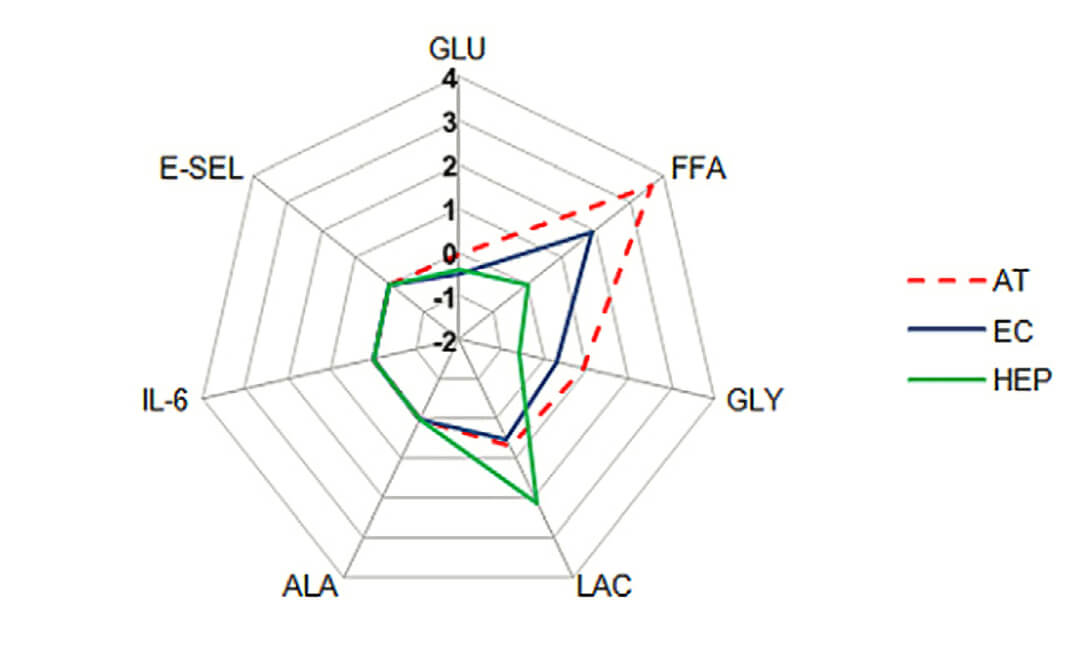
图 4. 流动培养的三维-脂肪组织+内皮细胞+肝细胞(AT+EC+HEP)能更好的维持代谢物的稳态平衡。与二维-脂肪组织+内皮细胞(AT+EC)相比,流动培养的三维-脂肪组织+内皮细胞+肝细胞(AT+EC+HEP)的葡萄糖,甘油和游离脂肪酸的水平在48 h内没有变化,而白蛋白的合成以及乳酸和L-丙氨酸的释放有所增加。GLU(葡萄糖),GLY(甘油),LAC(乳酸盐),ALA(L-丙氨酸),E-SEL(E-选择素)FFA(游离脂肪酸)。
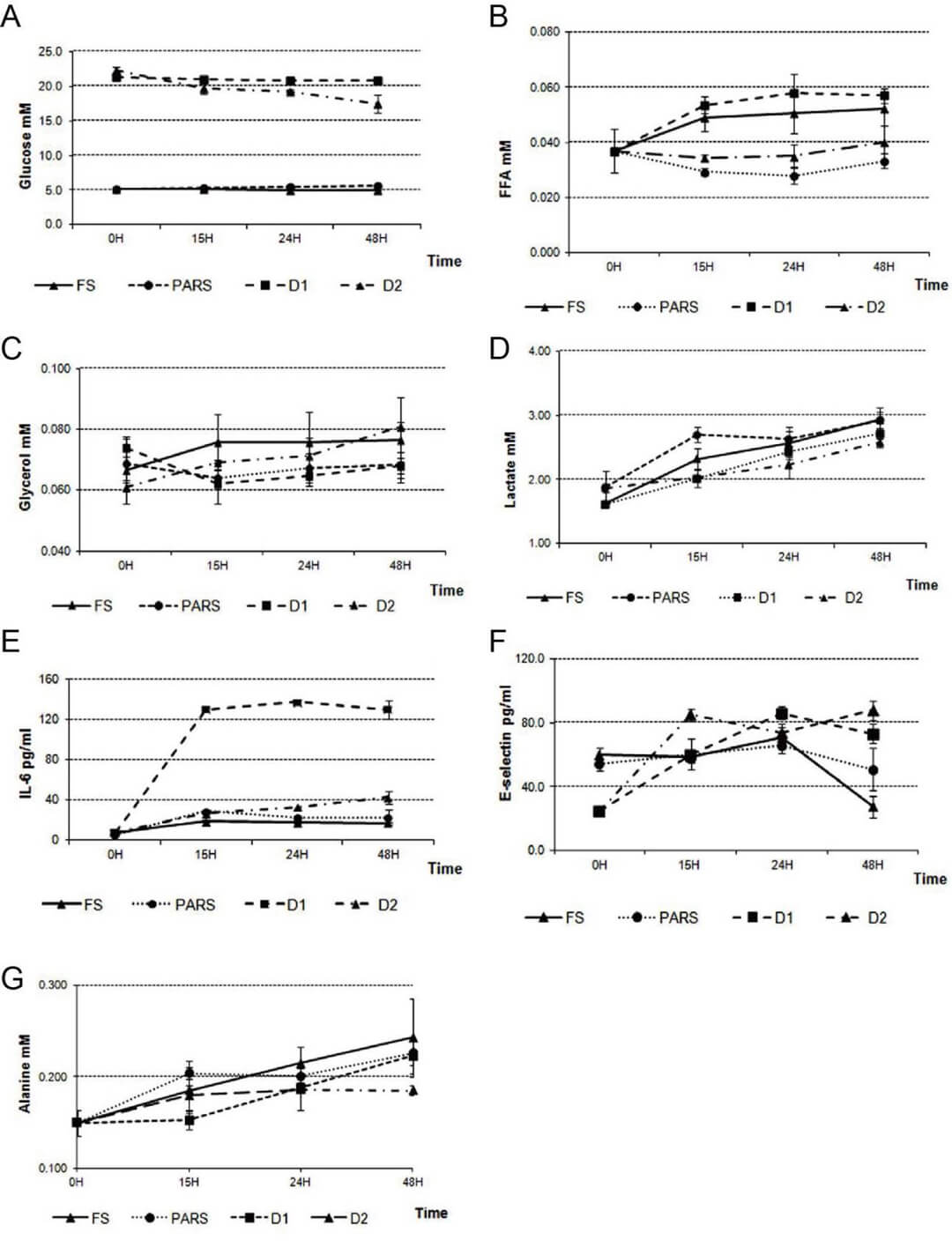
图 5 Quasi Vivo流动培养系统可以轻松取出旧培养基进行分析或补充新的培养基,在不同条件下进行长期实验而不会干扰细胞。适合同一细胞样品的多时间点连续取样。
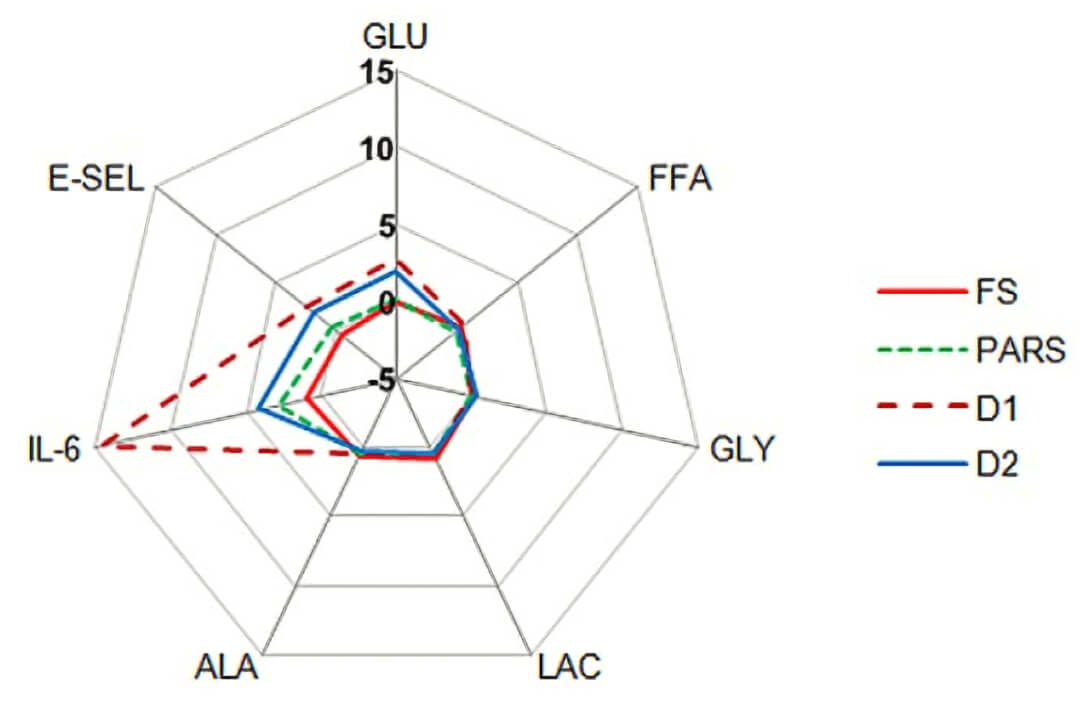
图6.流动培养的三维-脂肪组织+内皮细胞+肝细胞(AT+EC+HEP)模型能充分揭示葡萄糖过量和胰岛素不足导致的体外模型的总体平衡或体内稳态失衡,如何诱导一般的和特定的内皮应激的。FS(饥饿,培养基中含5.5 mM葡萄糖)PARS(血糖稳定状态,培养基中含5.5 mM葡萄糖和65 pM胰岛素)D1(I型糖尿病模型,培养基中含20 mM葡萄糖)D2(II型糖尿病模型,培养基中含20 mM葡萄糖和65 pM胰岛素)。
总结:
为模拟肝、脂肪组织和内皮在机体内的不同占比,流动培养48 h后肝细胞、脂肪细胞和内皮细胞终浓度应为10:2:1。流动培养时,肝细胞采用含有3 D支架的培养室,内皮细胞采用层流室。培养基的流速为250 mL/min。
Quasi Vivo流动培养系统,作为英国Kirkstall公司核心产品,10年来已在全球70+实验室使用,成功用于包括呼吸系统(研究热点)、心血管、肝脏、肾脏、肠道、血脑屏障和脑组织类器官等各类细胞模型中。
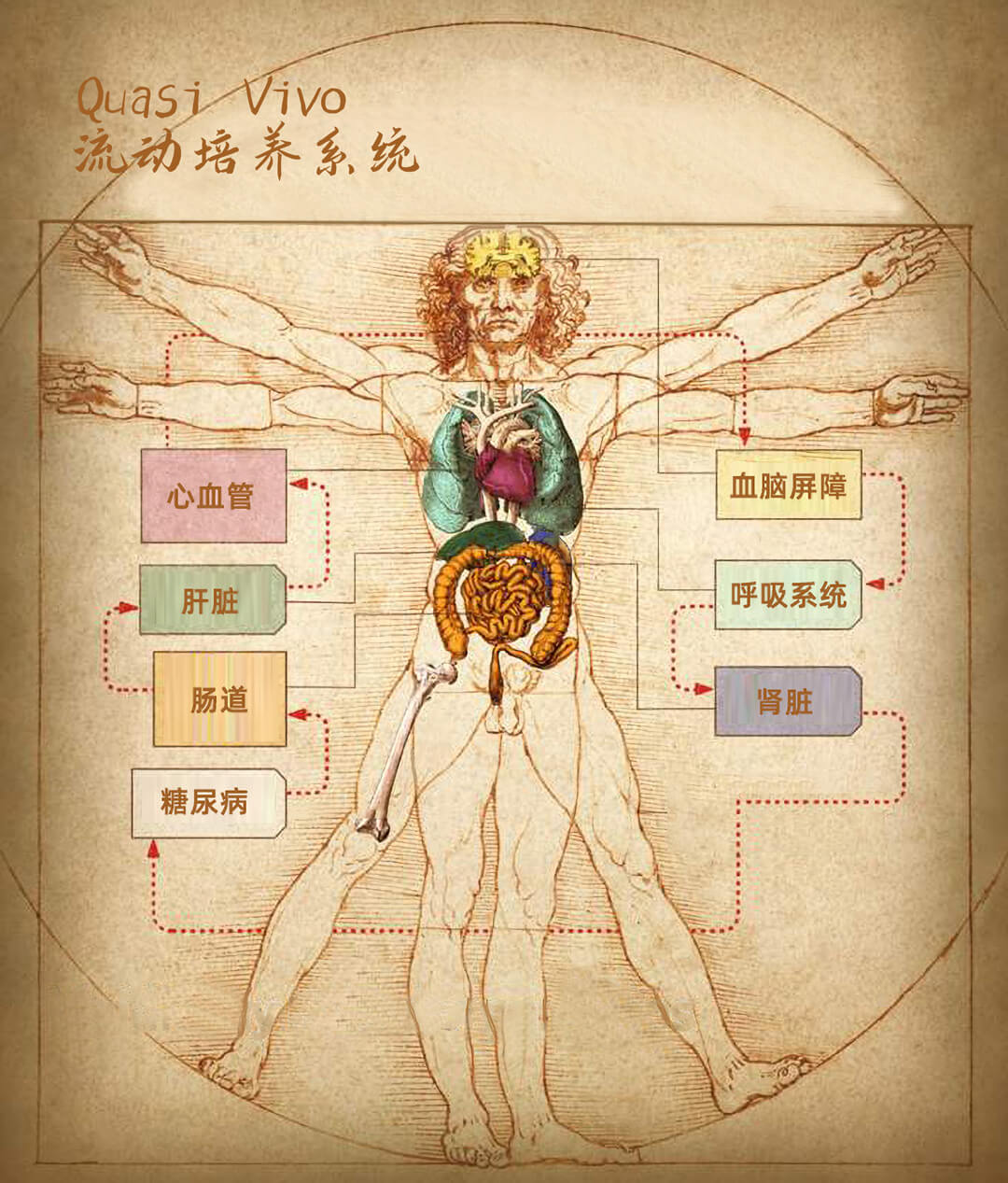
Quasi Vivo流动培养系统,贴壁细胞培养实验指导
Quasi Vivo参考文献
1.Tommaso S. et al., 2011. Engineering Quasi-Vivo in vitro organ models. Advances in Experimental Medicine and Biology Volume: 745, pp 138-153.
2.Patricia M. et al., 2018. A novel dynamic multicellular co-culture system for studying individual blood-brain barrier cell types in brain diseases and cytotoxicity testing. Scientific Reports Volume: 8, Issue: 1, pp 8784.
3.Basma E. et al. 2020. A dynamic perfusion based blood-brain barrier model for cytotoxicity testing and drug permeation. Scientific Reports Volume: 10, Issue: 1, pp 3788.
4.Miranda A. et al., 2016. A three dimensional (3D) human in vitro blood-brain barrier (BBB). Heart Volume: 102.
5.Buesch S. et al., 2018. A Novel In Vitro Liver Cell Culture Flow System Allowing Long-Term Metabolism and Hepatotoxicity Studies. Applied In Vitro Toxicology Volume: 4, Issue: 3, pp 232-237.
6.Alec O. et al., 2019. Development of an in vitro media perfusion model of Leishmania major macrophage infection. 2019 PLOS ONE Volume: 14, Issue: 7.
7.Sean M. et al., 2017. In-silico Characterisation of the Kirkstall QV900 In-Vitro System for Advanced Cell Culture. 5th International Conference on Computational and Mathematical Biomedical Engineering pp 1174-1177.
8.Ahluwalia A. et al., 2011. Hepatotoxicity of diclofenac in a Quasi-Vivo™ multicompartment bioreactor. oxicology Letters Volume: 205.
9.Tomlinson, L. et al., 2019. In vitro liver zonation of primary rat hepatocytes.Front. Bioeng. Biotechnol., 7(17).
10.Elbakary, B. and Badhan R. K. S, 2020. A dynamic perfusion based blood brain barrier model for cytotoxicity testing and drug permeation. Scientific Reports, 10(1),3788.
11.O’Keefe, A. et al., 2019. Development of an in vitro media perfusion model of Leishmania major macrophage infection. Plos One, 14(7).
12.Miranda-Azpiazu, P. et al., 2018. A novel dynamic multicellular co-culture system for studying individual blood-brain barrier cell types in brain diseases. Scientific Reports, 8, 8784.
13.Chandorkar, P. et al., 2017. Fast-track development of an in vitro 3D lung/immune cell model to study Aspergillus infections. Scientific Reports, 7, 11644.
14.Iori, E. et al., 2012. Glucose and fatty acid metabolism in a 3 tissue in-vitro model challenged with normo- and hyperglycaemia. PLoS ONE, 7(4).
15.Mattei, G., Giusti, S. & Ahluwalia, A., 2014. Design Criteria for Generating Physiologically Relevant In Vitro Models in Bioreactors. Processes, 2(3).
16.Mazzei, D. et al., 2010. A low shear stress modular bioreactor for connected cell culture under high flow rates. Biotechnology and Bioengineering, 106.
17.Nithiananthan, S. et al., 2016. Physiological Fluid Flow Moderates Fibroblast Responses to TGF-β1. Journal of Cellular Biochemistry, 13.
18.Ramachandran, S.D. et al., 2015. In vitro generation of functional liver organoid-like structures using adult human cells. PLoS ONE, 10(10).
19.Rashidi, H. et al., 2016. Fluid shear stress modulation of hepatocyte like cell function. Archives of Toxicology, 90, 7.
20.Vinci, B. et al., 2012. An in vitro model of glucose and lipid metabolism in a multicompartmental bioreactor. Biotechnology Journal, 7.
21.Iori, E. et al., 2012. Glucose and fatty acid metabolism in a 3 tissue in-vitro model challenged with normo- and hyperglycaemia. PLoS ONE, 7(4), pp.1–9.
22.Mattei, G., Giusti, S. & Ahluwalia, A., 2014. Design Criteria for Generating Physiologically Relevant In Vitro Models in Bioreactors. Processes, 2, pp.548–569.
23.Mazzei, D. et al., 2010. A low shear stress modular bioreactor for connected cell culture under high flow rates. Biotechnology and Bioengineering, 106, pp.127–137.
24.Nithiananthan, S. et al., 2016. Physiological Fluid Flow Moderates Fibroblast Responses to TGF-β1. Journal of cellular biochemistry, 13(October), pp.1–13. Available at:
25.Ramachandran, S.D. et al., 2015. In vitro generation of functional liver organoid-like structures using adult human cells. PLoS ONE, 10(10), pp.1–14.
26.Rashidi, H. et al., 2016. Fluid shear stress modulation of hepatocytelike cell function. Archives of Toxicology, pp.3–7.
27.Iori, E. et al., 2012. Glucose and fatty acid metabolism in a 3 tissue in-vitro model challenged with normo- and hyperglycaemia. PLoS ONE, 7(4).
28.Vinci, B. et al., 2011. Modular bioreactor for primary human hepatocyte culture: Medium flow stimulates expression and activity of detoxification genes. Biotechnology Journal, 6, pp.554–564.
29.Tommaso S. et al., 2011. Engineering Quasi-Vivo in vitro organ models. Advances in Experimental Medicine and Biology Volume: 745, pp 138-153.
30.Ahluwalia A. et al., 2011. Hepatotoxicity of diclofenac in a Quasi-Vivo™ multicompartment bioreactor. oxicology Letters Volume: 205.
Quasi Vivo流动培养系统相关文章
-流动培养原代肝细胞基因上调
-流动培养解决血脑屏障3种贴壁细胞共培养
-流动培养在3D培养中初步获得心肌细胞结构和功能
-流动培养提高气液界面培养人支气管上皮细胞分化
LONZA人原代细胞相关产品
-人脐静脉内皮细胞和培养基
点击右侧在线咨询,获取Quasi Vivo流动培养系统免费技术咨询+报价
——Quasi Vivo中国独家代理商,北京泽平